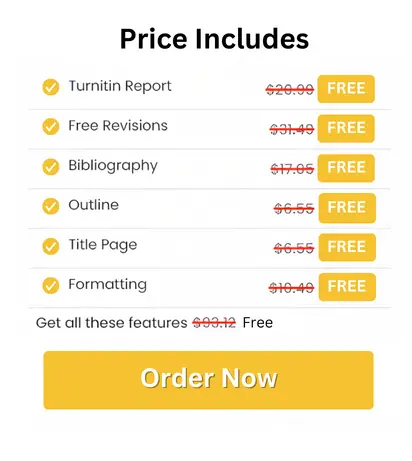
MGT607 Innovation, Creativity & Entrepreneurship Case Study Assignment Sample
ASSESSMENT BRIEF
Context:
Innovation, creativity and entrepreneurship can come in many different forms and be successful for many reasons. As such, being able to recognise these will broaden your understanding and appreciation for the important role of entrepreneurship and innovation in society today.
This assessment requires students to critically analyse a case study utilising the theory learnt in Module 1 and Module 2. It is important you draw on the concepts of innovation, creativity and entrepreneurship and link them to the case study to support your discussion and any recommendations you may have.
Instructions:
You will be required to watch the video contained in the separate file “Assessment 1 Video” and prepare a business style report. You must ensure that you incorporate the theories, which you learn in Module 1 and Module 2 to support your discussion. Specifically some of the questions you should be considering are:
• How does the case specifically demonstrate an entrepreneurial mindset?
• How does the case adopt theories of creativity to solve the specific problem?
• How does the case show an innovative approach to meeting a customer need?
Whilst the format may vary for your report, below is suggested format for you to follow:
• Cover page
• Background [approximately 150 words]. This will provide an introduction to your case study.
• Main Discussion / Opportunity [500-600 words]. This section should use the questions above as the basis for your discussion.
• Recommendations / Conclusion [200-300 words] Is there anything you think could have been done differently?
• What are your key learnings, which you have taken away from the case study?
• Appendices where applicable.
Your case study will be assessed based on the Rubric below and is limited to a word count of 1,000 words excluding the cover page.
Referencing:
You must recognise all sources of information; including images that you include in your work. Reference your work according to the APA 7th edition guidelines. Please see more information on referencing here http://library.laureate.net.au/research_skills/referencing
Solution
Introduction and Background
There is new discovery when it comes to microscopes making it durable, accessible, and cheap to manufacture which is a foldscope. It is a new portable microscope that is designed with origami paper and an optical lens. Scientist Manu Prakash was the man behind this innovation as he made an innovative approach to make a microscope lens that is cheap and would be accessible to everyone. One foldscope is said to cost $1 to produce, and it is sold for around $4. This innovation was part of the Frugal Science Movement. This movement has the aim to minimize the production cost of tools and make it easy and cheap.
Discussion
1. How does the case specifically demonstrate an entrepreneurial mindset?
The case of Foldscope can exemplify an entrepreneurial mindset. An entrepreneurial mindset can be defined by seizing opportunities using creative leaps. These leaps drive motivation by connecting the dots between existing knowledge and creating new market opportunities (Picard, 2018, p.46). Foldscope can be stated as an example of an entrepreneurial mindset that shows a unique approach and drive toward solution.
Manu Prakash realized the limitations of a traditional microscope and its cost, scope, and portability. He also saw the need for options that were less expensive. The idea for Foldscope came from this. It is much cheaper and easier to carry around. The fact that diseases like dengue and malaria were common there made it even more useful for poor countries. Manu Prakash chose to use folded paper to make this microscope (Hernández-Pérez & Nieto-Sobrino, 2022, p.927). In addition to fixing the problems with regular microscopes, this was also a cheap and accessible option. This shows a business spirit because making this foldscope took a lot of design study on the tech side of it (Cybulski et al. 2014, p.08). Manu Prakash had to find a creative way to make a microscope out of foldable paper. It was waterproof as well to make it suitable for fieldwork. This goes on to show the entrepreneurial mindset the team of Manu Prakash had for university assignment help.
The team also showcased an aim to revolutionize the microscope by adding the use and throw factor to it. This allowed for a mass production of these microscopes, making it accessible for a wider population (Chavali & Ramji, 2018, p.108). This shows Manu Prakash’s entrepreneurial skills in terms of scalability.
2. How does the case adopt theories of creativity to solve the specific problem?
Creativity 4 P’s model
The Creativity 4P’s model was formulated by Rhodes in 1961. The creativity model was formulated to analyze and understand creativity from four different perspectives. The 4Ps of this model are person, product, process and press of environment.
The first P in the creativity 4P’s model is Person. The creativity of an entrepreneur is signified by the ability to develop new ideas and solve problems. The ability to predict the future and generate innovation and ideas before its time can also be attributed to Manu Prakash’s creativity. His creativity also involves solving the problems of customers before they are even problems. In the video, Scientist Manu Prakash also talks about adopting different creative approaches and theories to solve specific problems. A creative approach toward problems provides scalable and affordable solutions.
The second P in the creativity 4P’s model is the product. Manu Prakash talks about the innovative product of making a microscope to identify diseases like malaria and Guardia with the help of nothing more than origami paper (Ganesan et al. 2022, p.24). That same origami paper would develop into a foldscope through innovation. This foldscope would operate in the same way as a traditional microscope. (Chang et al. 2024, p.86). The foldscope product also has minute microscopic functionalities like a bright field, contrast, fluorescence, polarization, and others. The Foldscope product is also a portable, disposable, and cost-effective design as it costs only around $2.
The Process is the third P in the 4P’s Creativity model. In this case, the theory of creativity is visible when it comes to the designing of foldscopes. It is made of a single sheet of origami paper, with the incorporation of different optical components for focusing it on the microscopic organisms and viewing them (Pretorius et al. 2023, p.12). The lens inside the foldscope is a glass ball. Magnets are also present in the foldscope. The magnets align and place the lens in the middle in the folding process, helping the foldscope to achieve the origami technique. The techniques allow optical alignment with micron-scale accuracy. This is a showcase of extreme engineering in a very simple design. This case is a demonstration of creative design and engineering in real-world challenges (Pollina et al. 2022, p.94). The user can also throw the microscope after use, or if there is any reason it gets damaged, the user can always make a new one in a matter of minutes. This innovative approach addresses the scalability issues in diagnosing microscopic bacteria with the possibility of coming up with accessible tools that can be used by anyone.
3. How does the case show an innovative approach to meeting customer needs?
The approach to better the existing solutions, which meets new ever-changing requirements, and market needs is called the innovative approach. This is done by new processes, services, and technologies and by making the existing product more useful by some technical changes or the addition of newer engineering.
In the Video, scientist Manu Prakash shows a solution based on Foldscopes to battle the challenges of diagnosing and understanding at the microscopic level (Li et al. 2024, p.15). There are various limitations to traditional microscopes in terms of being bulky, expensive, and not designed for field testing. There are also several problems when it comes to scalability and issues in diagnostics (Chang et al., 2024, p.12). This is what led to the creation of Foldscopes. It is made entirely from folded paper and offers the functionality of real scopes (Ganesan et al. 2022, p.3485). Even though being made from origami paper these foldscopes are durable and waterproof, making them suitable for outside and fieldwork. foldscopes show how a scope that is cheap to build has more functionalities like a bright field, polarization, fluorescence, contrast, and others (Krishnamurthy et al. 2020, p.1050). The cost-effective manufacturing method and engineering behind the scenes have revolutionized the microscope industry. By using these methods, the microscopes can be distributed easily and can be disposed of after use.
In the video, Scientist Manu Prakash talks about using the Foldscope to gather thousands of data on different microscopic diseases like Malaria, Giardia, Chagas, and others. This integration would help science to diagnose microscopic-level bacteria and point them toward affordable and scalable tools.
Press is the 4th P in the Creativity 4P’s model of Rhoades. Press signifies the environment which inspired the founder. Press also shows what environment the founder operated in. Manu Prakash, before founding Foldscope worked at Stanford University as a Bio-Engineering professor. He found in his surrounding environment that in field stations, the microscopes present were broken, and faulty. The microscopes were also very bulky. This inspired Manu Prakash to innovate and create a foldscope which solved all these problems. He also realized that the microscopes present in the market were very expensive, and not everyone could afford them, especially in developing countries where diseases like malaria and dengue were still widespread and could not be tested due to lack of proper equipment. This is what inspired Manu Prakash to build a microscope which could be folded like origami to make it portable. This also made the foldscope very cost-effective as it cost only $2 to own a foldscope and everybody could get their hands on it.
Recommendations
Foldscope came out in the year 2014 and instantly became a popular product. Over 1.7 million foldscopes have been sold till now. There are a few drawbacks to the product, addressing which could make the product even better.
? Manu Prakash should use high resolution lenses in the foldscope to improve the resolution of the lenses in the Foldscope (Das et al. 2021, p.220)
? Manu Prakash should install a light source in the foldscope to address the issue that the product could not be used under dark conditions.
Conclusion
To conclude, the case of Foldscope showcases an entrepreneurial mindset from various aspects. Manu Prakash, the spearhead of this project, identified the limitations of a traditional microscope and realized the requirement of a more cost-effective and portable microscope that can be easily accessed by developing countries as well. He also came up with innovative solutions for creating a microscope entirely made of foldable paper and addressing the traditional microscope issue. He also implemented the use and throw aspect, showing his entrepreneurial mindset. Integrating Foldscopes into science education also highlights the focus on meeting customer needs by empowering individuals with accessible tools for disease diagnosis. The case of Foldscope overall demonstrates the true entrepreneurial mindset of identifying problems, solving the issues using innovation and creativity and meeting customer needs.
References
Chang, R., Davydov, A., Jaroenlak, P., Budaitis, B., Ekiert, D. C., Bhabha, G., & Prakash, M. (2024). Energetics of the mokicrosporidian polar tube invasion machinery. Elife, 12, RP86638. https://doi.org/10.7554/eLife.86638
Chavali, A. K., & Ramji, R. (Eds.). (2018). Frugal innovation in bioengineering for the detection of infectious diseases. Springer. https://doi.org/10.1007/978-3-319-66647-1
Cybulski, J. S., Clements, J., & Prakash, M. (2014). Foldscope: origami-based paper microscope. PloS one, 9(6), e98781. https://doi.org/10.1371/journal.pone.0098781
Das, K., Dutta, P., & Gogoi, J. (2021). ‘Foldscope’-A simple and economical microscope. Journal of Biological Education, 55(2), 217-222. https://doi.org/10.1080/00219266.2019.1682641
Ganesan, M., Selvan Christyraj, J. R. S., Venkatachalam, S., Yesudhason, B. V., Chelladurai, K. S., Mohan, M., ... & Christyraj, J. D. S. (2022). Foldscope microscope, an inexpensive alternative tool to conventional microscopy—applications in research and education: a review. Microscopy Research and Technique, 85(11), 3484-3494. DOI: 10.1002/jemt.24205 . https://doi.org/10.1002/jemt. 24205
Hernández-Pérez, C., & Nieto-Sobrino, M. (2022). Foldscope as an Innovative Teaching Tool. Education Sciences, 12(12), 927. https://doi.org/10.3390/educsci12120927
Krishnamurthy, D., Li, H., Benoit du Rey, F., Cambournac, P., Larson, A. G., Li, E., & Prakash, M. (2020). Scale-free vertical tracking microscopy. Nature Methods, 17(10), 1040-1051. https://doi.org/10.1038/s41592-020-0924-7
Li, E., Saggiomo, V., Ouyang, W., Prakash, M., & Diederich, B. (2024). ESPressoscope: a small and powerful platform for in situ microscopy. bioRxiv, 2024-01. https://doi.org/10.1101/2024.01.20.576174
Picard, Y. (2018). Microscopy & Microanalysis 2018. Microscopy Today, 26(3), 46-47. https://doi.org/10.1017/S1551929518000512
Pollina, T., Larson, A. G., Lombard, F., Li, H., Le Guen, D., Colin, S., ... & Prakash, M. (2022). PlanktoScope: affordable modular quantitative imaging platform for citizen oceanography. Frontiers in Marine Science, 9, 949428. https://doi.org/10.3389/fmars.2022.949428
Pretorius, J., de Beer, J., & Jackson, C. (2023). The Possible Uses of Foldscopes as a Form of Frugal Science in the Biology Classroom as Well as in Out-of-School Science Activities. Research in Social Sciences and Technology, 8(3), 1-15. https://doi.org/10.46303/ressat.2023.17




 81 Isla Avenue Glenroy, Mel, VIC, 3046 AU
81 Isla Avenue Glenroy, Mel, VIC, 3046 AU



